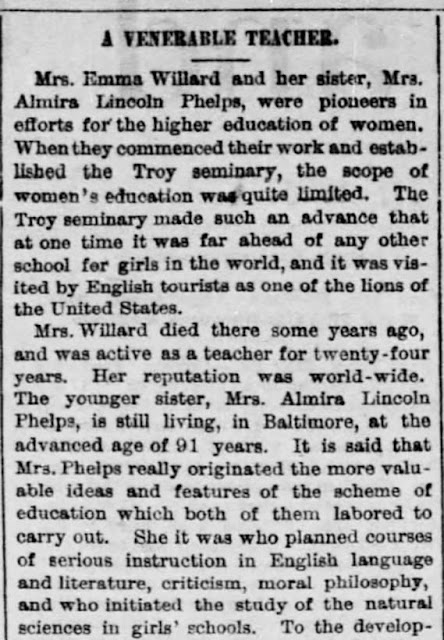Herbarium #5 Clover Wreath by Becky Brown
The block recalls Almira Lincoln Phelps.
Almira Hart Lincoln Phelps (1793-1884)
UPDATE: The more I look at this photo the less likely I think it's Almira. The dress style is circa 1860 I am guessing and Almira would have been 67. Not her style. See next photo.
Almira Hart and her older sister Emma Hart Willard (1787-1870), innovators
in women's education, were from a family of 17 in Berlin, Connecticut.
Emma founded the Troy Female Seminary, New York school in 1821.
Clover Wreath by Becky Collis
Account of sisterly rivalry in 1884
Enoch Pratt Library
The Institute's classical revival building overlooked the Patapsco River.
Virginia Museum of History & Culture
Maria Ann Glanville Coleman Jerdone Pettus (1833-1879)
Maria seems to have been fond of botanizing.
From her Find A Grave files:
Robyn Gragg turned her Clover Wreath into a pentagram.
 Almira made money off all those textbooks, enabling her to retire with $50,000 in real estate and $75,000 in other wealth according to the 1860 census. Her assets in Baltimore---all too common at the time--- included slaves. Here 2 Black women and a man are living at her residence in the city. They must be free people as the census did not name slaves.
Almira made money off all those textbooks, enabling her to retire with $50,000 in real estate and $75,000 in other wealth according to the 1860 census. Her assets in Baltimore---all too common at the time--- included slaves. Here 2 Black women and a man are living at her residence in the city. They must be free people as the census did not name slaves.The 1860 Slave Schedule shows four enslaved people, 2
unnamed women, a man and a two-year old boy.
Despite her acceptance of the Southern economic system Almira remained true to her Connecticut culture as a Union sympathizer in Union Maryland.
Students at Patapsco in the late-19th century.
The school closed in 1896.
In the pre-preservation 20th century the magnificent school building fell to ruin
but the shell been rebuilt as a monument in a park.
The Block
Three similar wreaths from the 8 herbarium quilts
The quilt in the Shelburne Museum's collection tells
us it is a Clover Wreath.
Almira shows the Clover and explains the inflorescence.
And the ternate leaves.
Red Clover Tryfolium pratense from about 1800
Working on a more balanced composition: larger ternate leaves,
rounder sessile flowers.
Clover Wreath by Denniele Bohannon
Print the pattern on an 8-1/2" x 11" sheet. Note the inch square for scale.
You might want to shade the clover blossoms by piecing
green and red strips
And placing your templates over the seam line.
My Clover Wreath, glued up and ready to stitch.
Almira gave a talk about her own Herbarium in 1874 at the Maryland Academy of Sciences where she seems to have donated the collection. It was quite an honor to be considered scientist enough to be a female member. She died on her 91st birthday ten years later.
Almira's Find A Grave files.

























No comments:
Post a Comment